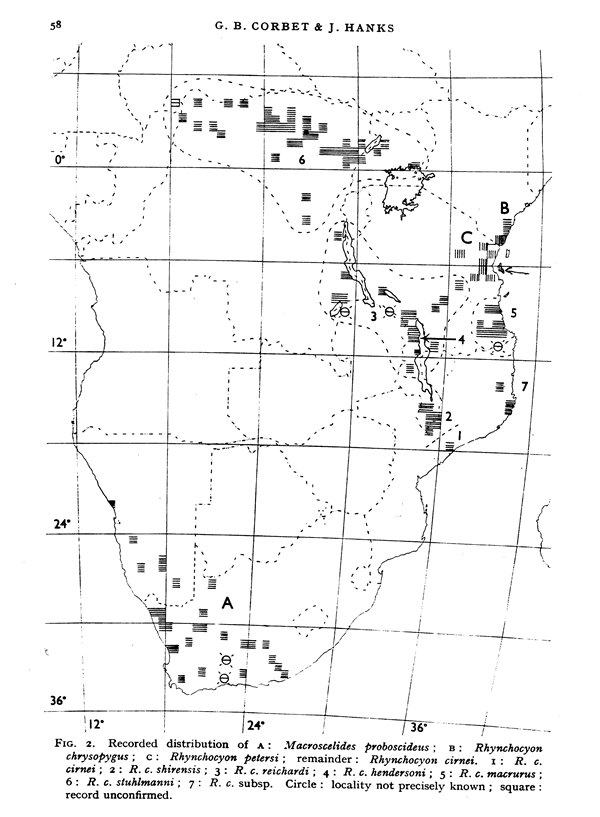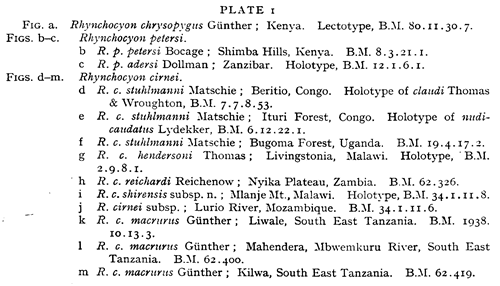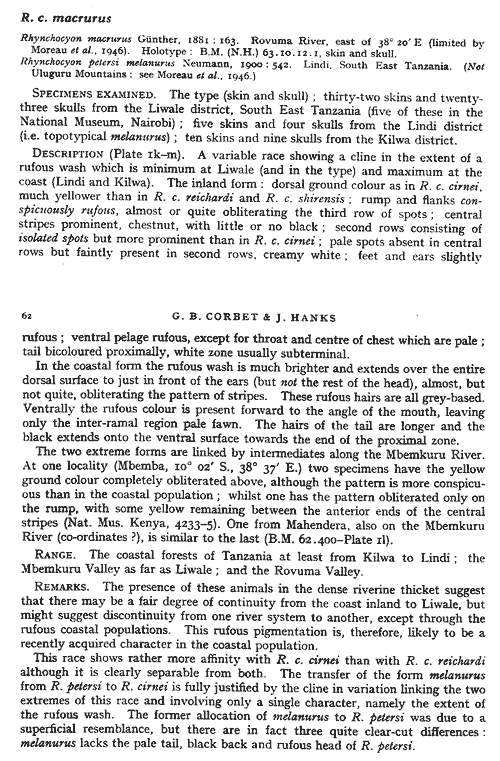Which Giant Forest Sengi (Rhynchocyon) did you see?
In most forest and dense woodland habitats where Rhynchocyon occurs, it is relatively easy to distinguish the three species visually. However, R. cirnei has several subspecies and at least one of these may be difficult to distinguish from R. petersi, especially under field conditions. To assist you in determining which species you observe in the field, several items have been reproduced below from:
Corbet, G. B. & Hanks, J. 1968. A revision of the elephant-shrews, Family Macroscelididae. Bulletin of the British Museum (Natural History) Zoology, 16, 47-111.
Figure 2 below shows the distribution of the three species of Rhynchocyon based on actual museum specimens. Unless a surprising discovery is made, it is likely that these gross distributions are definitive.

Plate 1 with caption below shows representative study skins of the species and subspecies of Rhynchocyon. Note that R. petersi (b and c) and R. c. macrurus from the Lindi area (m) are VERY similar in gross appearance – especially if seen briefly in the poor lighting of a forest.


The spatial relationship of these two taxa is not completely clear. They may have distributions that are close or maybe even meet somewhere in central Tanzania. According to Corbet and Hanks (1968):

Over the last couple of years Tom Butynski and I have received numerous sightings of giant forest sengis (Rhynchocyon) from many colleagues that have been surveying plants, primates, and birds in Tanzanian forests. We greatly appreciate these data and we are beginning to better understand the distribution of this genus in eastern Africa. Many of these reports are straight forward, but there are two areas where we are getting contradictory sightings in terms of which of the Rhynchocyon taxa were sighted.
First, a summary of the distribution of giant forest sengis in Kenya and Tanzania (based on the revision by Corbet and Hanks, 1968, (see above) and all the sightings we have accumulated): The Golden-rumped Sengi (R. chyrsopygus) is found north of the Kombeni River (inland from Mombasa) while the Black and Rufous Sengi (R. petersi) is found to the south (e.g., Ribe Hills and Rabai Hills, respectively). R. petersi continues south further into the Eastern Arc forests and in coastal forests as far as the Rufiji River, including Zanzibar and Mafia islands. There are several distinct subspecies of the Chequered Sengi, R. cirnei (see Corbet and Hanks material above). The particularly dark R. c. macrurus is found south of the Rufiji River and on down into Mozambique (?) and inland to at least Liwale. In the Eastern Arc mountains, the distinctly chequered R. cirneireichardi extends north from the forests associated with the Rift Valley and Lake Malawi into the Udzungwa Mountains and apparently reaches the Rubeho and Uvidunda mountains. Eastern Arc forests further north (e.g., Uguru and Uluguru mountains, etc.) are occupied by R. petersi.
However, we have received reports of R. petersi in coastal Tanzania south of the Rufiji River and both R. petersi and R. cirnei (presumably as illustrated in most field guides) in the Udzungwa Mountains. The confusion as to which species of Rhynchocyon is found south of the Rufiji River is easily explained by mistaken identification of the VERY similar R. petersi (north of about the Rufiji River) and R. cirnei macrurus. The latter is a very dark form of the Chequered Sengi with very indistinct chequers. Indeed, these two forms are so similar that R. c. macrurus was originally described as a subspecies of R. petersi (see material from Corbet and Hanks, 1968, above, and also photos below).
The confusion in the Udzungwa Mountains of Tanzania is less easily understood. However, if we follow the taxonomy and distribution of Rhynchocyon as found in Corbet and Hanks (1968) there are two possibilities. First (not likely in my mind), is that R. petersi extends further to the southwest along the Easter Arc mountain chain than has been documented in the past, and thus it occurs in the Udzungwa Mountains along with R. c. reichardi. This explanation would result in these two species meeting, or perhaps even overlapping in some way, in the Udzungwa Mountains. The other possibility, which in my mind is more parsimonious with Corbet and Hanks (1968), is that there are two subspecies of R. cirnei in the Udzungwa Mountains area – R.c. reichardi, which is documented by Corbet and Hanks (1968) in this area as described above, and a second darker subspecies. This dark sengi may be R.c. macrurus extending inland along riparian forests from the coast to the Udzungwa Mountains (does suitable habitat actually exist through the Selous Game Reserve?). The last possibility (least likely in my mind) would be a dark subspecies isolated in the Udzungwa Mountains that is undescribed by Corbet and Hanks (1968). This scenario might be similar to the slightly darker R. c. hendersoni from the high elevation Livingstonia area on the western side of Lake Malawi, which is surrounded by the lighter R. c. reichardi. If this is the case, perhaps there is also an elevational separation of R. c. reichardi and the mystery darker form in the Udzungwa Mountains.
In order to help resolve the question as to which Rhynchocyon occurs in the Udzungwa Mountains and exactly where the forms are found in this region, it becomes critical that observers are familiar with the traits that distinguish R. petersi and R. c. macrurus. The former compared to the latter has 1) much lighter tail (not including variable white tip) and possibly pinnae; 2) a rufous head with no grizzling on forehead and side of face and nose; and 3) jet black back, rump, sides, and flanks. See material above from Corbet and Hanks (1968). These traits are further illustrated in the following three photographs:
Photo 1 (G. Rathbun, specimens in the British Museum of Natural History, London). Rhynchocyon cirnei macrurus from Lingaula, Tanzania (top, BMNH 62.419) and Mbati, Kilwa, Tanzania (bottom, BMNH 62.423).

Photo 2 (G. Rathbun, specimens in BMNH, London). Rhynchocyon petersi petersi from Kwale, Shimba Hills, Kenya (top, BMNH 10.9.22.11) and Chwaka, Tanzania (bottom, BMNH 55.148).

Photo 3 (H. Hellmuth, Philadelphia Zoo). Captive Rhynchocyon petersi mother and young ( Tanzania origin unknown). Note very light coloured pinnae and tail, jet black posterior, and rufous head.

To date, we have no indication of Rhynchocyon occurring in the Ukaguru or Mahenge mountains of the Eastern Arc, so if you have any data from forests in these areas please let me know. Also, it is not clear if Rhynchocyon occurs in riparian forests or dense woodlands through the Selous Game Reserve, which separates the Udzungwa Mountains and coastal forests. Further data from the Udzungwa region will be helpful in figuring out the situation there. Lastly, the occurrence and distribution of R. chrysopygus north of the Tana River in Kenya (Boni and Dodori forests) needs better definition.
In conclusion, if you are working in the coastal areas of Tanzania from the Rufigi River south or inland from this region through the Udzungwa Mountains, it will be helpful to be familiar with the currently recognized forms of Rhynchocyon that are likely to be in this region. Photographs of captured animals or voucher specimens may be the only way we can resolve the various identification and distribution questions – but good sightings with the above material in mind are always welcome.
Many thanks for your past and future observations.
Galen B. Rathbun
Chair, IUCN-SSC Afrotheria Specialist Group
Department of Ornithology and Mammalogy
California Academy of Sciences ( San Francisco)
c/o P.O. Box 202
Cambria , California 93428, USA